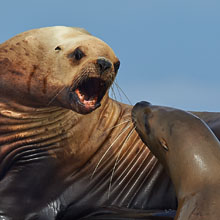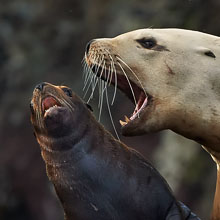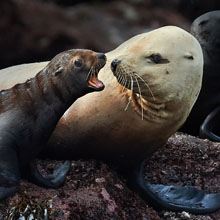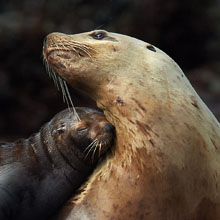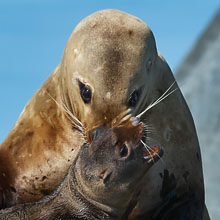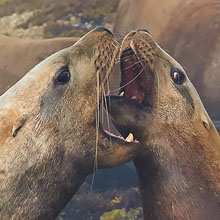Availability: Undetermined - Enquiries?
In the Field
Back Talk! Northern Vancouver Island, BC, Canada. August 20, 2012.
Have I mentioned (recently) how darned much I like photographing Steller Sea Lions? ;-)
This is the second shot in a sequence showing a pretty intense encounter between a female Steller's sea Lion and her pup. In this shot junior has clearly recovered from a major "blast" mom gave him about two minutes back. So much so that he's feeling bold enough to give her a little "back talk" of his own. Lippy little dude - but I guess in order to survive they have to learn to give as good as they take. Mom seems to be absorbing his abuse without a worry - heck, she almost looks like she's in an understanding and sympathetic mood!
Here's a higher resolution (2400 pixel) version of Junior pleading his case:
• Back Talk! Download 2400 pixel image (JPEG: 1.9 MB)
ADDITIONAL NOTES:
1. This image - in all resolutions - is protected by copyright. I'm fine with personal uses of it (including use as desktop backgrounds or screensavers on your own computer), but unauthorized commercial use of the image is prohibited by law. Thanks in advance for respecting my copyright!
2. Like all wildlife photographs on this website, this image was captured following the strict ethical guidelines described in The Wildlife FIRST! Principles of Photographer Conduct. I encourage all wildlife photographers to always put the welfare of their subjects above the value of their photographs.
3. This image was captured during my "Humpback, Orcas, Sea Lions & More" photo tour in August of 2012. Each year I offer trips into two different parts of the Great Bear Rainforest as well as one to photograph aquatic mammals and oceanscapes near the northern tip of Vancouver Island. And, in selected years, I also offer photo tours to locations to capture other highly sought-after subjects, such as various owl species of the boreal forest and wildlife of Canada's Arctic. Details about these trips can be found on the Photo Tours page of this website.
Behind the Camera
Back Talk! Northern Vancouver Island, BC, Canada. August 20, 2012.
Digital Capture; RAW 14-bit format; ISO 1800.
Nikon D4 paired with Nikkor 400mm f2.8G VR lens. Hand held in floating/bobbing zodiac. VR on and in normal mode.
1/1600s @ f5.6; -1.0 stop compensation from matrix-metered exposure setting. Auto ISO engaged.
At the Computer
Back Talk! Northern Vancouver Island, BC, Canada. August 20, 2012.
RAW Conversion to 16-bit TIFF, including first-pass/capture sharpening using Capture One Pro Version 7. Three raw variants (processed from raw) differing by a total of 1.0 stops in exposure.
Further digital corrections on resulting 16-bit TIFF files using Adobe's Photoshop CS6 and Light Craft's Lightzone. Photoshop adjustments including compositing the raw conversion exposure variants, selective tweaks to exposure and selective colour desaturation (both of these using adjustment layers), and selective sharpening for web output. Final tone tweaking performed using tonemapper/re-light tool in Lightzone.
Conservation
Back Talk! Northern Vancouver Island, BC, Canada. August 20, 2012.
Ten percent of the revenue generated by this image will be donated to Raincoast*.
Species Status in Canada**: Special Concern (November 2003) - protected in Canada since 1970.
The Steller's Sea-Lion (Eumetopias jubatus) is the largest of the sea-lions, and males can weigh up to a ton (females are considerably smaller and rarely weigh over 600 lb). Males compete among themselves for females, and successful males end up breeding with several females within their harem.
From the early 1900's through to the 1970's huge numbers of Steller's Sea-Lions were culled for their fur and to remove a competitor (for humans) for salmon. During that time approximately 55,000 sea lions were killed and the breeding population of BC was lowered to about 4,000 animals. Since the Steller Sea Lion first received protection in 1970 the population in the coastal waters of BC has grown to between 18,000 to 19,700 animals (7,600 or so of these are of breeding age).
*The Raincoast Conservation Society (and Foundation) is an effective and efficient organization that has been fighting for protection of this unique habitat. If you are looking for a meaningful way to contribute to the conservation of this amazing ecosystem, Raincoast will provide maximal "bang" for your conservation dollars.
**as determined by COSEWIC: The Committee on the Status of Endangered Wildlife in Canada



















